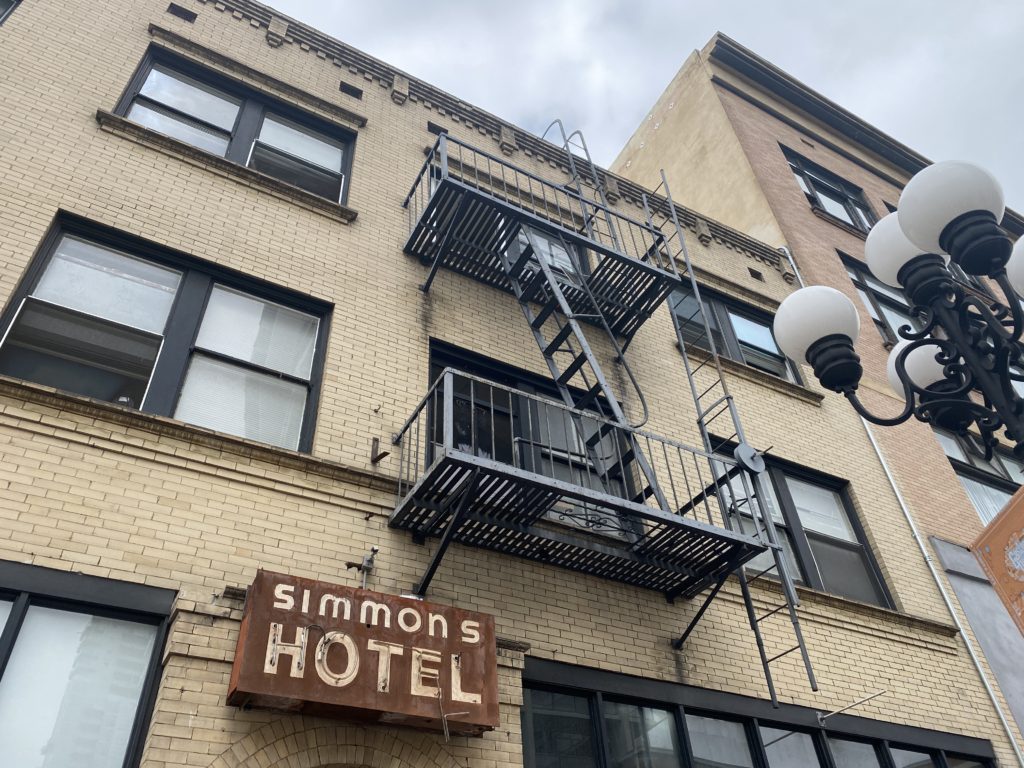No products in the cart.
Landmarks
One of Many……
The Simmons Hotel
(1906)
The New York Hotel
(1906)
520 – 544 6th Avenue
Architectural Stye: Early 20th Century Commercial
Architect: Edwin Blachman
Principle Contractor: Mortz-Trepte
During the early 20th century, many small hotels sprang into construction in answer to the foreseeable need for accommodations for tourists coming to the proposed Panama-California Exposition. The exposition was planned to celebrate the opening of the Panama Canal, and was meant to tout San Diego as the first U.S. port of call for ships traveling north after passing westward through the canal. Guests were estimated to number at least a million; they far exceeded this estimate, ultimately totaling 3,747,916. After a massive fundraising effort the exposition came to pass.
At midnight (in San Diego) on December 31, 1914, President Woodrow Wilson ceremoniously pushed a telegraph button in Washington, D.C. to open the expo by turning on the power and lights at the park. In addition, a lit balloon located 1,500 feet above the park further brightened the exposition. Guns at nearby Fort Rosecrans and on Navy ships in San Diego Bay also were fired to signal the opening.
Admission for adults was $0.50 ($13 today) and $0.25 ($7 today) for children. Based on varying sources, the opening day’s attendance was between 31,836 and 42,486.
The tourist business was booming, and all the small hotels were put to good use, not only for the droves of tourists, but also for San Diego’s burgeoning population. Affordable housing, like now, was a big issue! One such new structure was what is now known as the Simmons Hotel. Another was its next-door neighbor, the New York Hotel. Both featured single-room
occupancy housing, then known as “furnished rooms.” The buildings were built in close conjunction with each other and were nearly architecturally identical.
Originally, the Simmons was called the Burbank (1907) , then the Sixth Street Rooms (1908), then the Prescott (1909-1918), and finally the Hotel North in 1921.
It was not called the Simmons until 1965. The building was built on the site of the San Diego Granite Works.
The owner of the property was Carl Alex Johnson, a lawyer. He had strong ambitions, but rather limited abilities. He was a candidate for Supreme Court Judge, ran for California Governor, and was even “considered” for Vice-President. In all three cases he was unsuccessful losing by large margins to his opponents.
The edifice is an 85 by 48 foot, three-story, rectangular brick structure with a composite roof featuring an 18- inch parapet above it.The second and third floors have wooden window openings, standard fire doors and an iron chimney. Two stores occupied the first floor separated by an arched central entrance leading to the second and third floors. Decorative flat pilasters divide the street level into two main sections. Horizontal wooden bands divided the windows to give the appearance of transoms.
The street level housed a variety of businesses throughout the years including the Sixth Street Bank, Stephen Millichamp Paints and Wallpaper, Masuda and Herose Grocers, the Sterling Company, a second hand goods store, and C.A. Philips Furniture. From 1925 until 1930, additional businesses were M. Herman Building Materials, Logan Transfer Company and C. W. Irwin Express.
By 1916, Johnson had been foreclosed on, and the building went through a series of owners, including for a short time, the Metropolitan Hotel on Fifth Avenue. It ultimately transferred to McClurken Machinery Inc. well into the late 1990s.
The New York Hotel, although architecturally similar, is two stories with a more elaborate roofline, and a stunning light well illuminating the stairs to the second floor landing. The roofline features decorative dentil molding , carved relief and a plain horizontal stringcourse that extend across the main facade. The second level is accessed through a rectangular wooden door. Like the Simmons, it was built as a hotel with retail on the street level.
The furnished rooms were originally known as the Fernbrook (1907-1918), and then the Hotel Van Horne (1920-1925). From 1925-1930, it became the Hotel De Luxe. The street level housed enterprises ranging from a seed store to a social club to a paint store.
The two hotels are still serving the same purpose they were originally built for. They both offer low-cost housing on the upper floors. However, the New York Hotel is now empty on the street level, while the Simmons houses a beauty and personal services salon. Some things change, some stay the same.
Sandee is the Historian for the Gaslamp Quarter Historical Foundation. She can be reached at [email protected].

